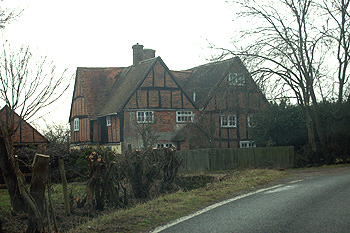Hoo Farmhouse - 71 Cranfield Road Wootton

71 Cranfield Road March 2012
71 Cranfield Road, Hoo Farmhouse, is a most attractive old building. It was listed by English Heritage in August 1987 as Grade II, of special interest. It is a 17th century property, timber-framed with red brick nogging (infill) and built in an L-shape, with the angle later filled in by a new wing. The house has an old clay tiled roof and comprises two storeys and attics.
The Rating and Valuation Act 1925 specified that every building and piece of land in the country was to be assessed to determine its rateable value. Like most of the county, Wootton was largely assessed in 1927 and the valuer visiting Hoo Farm [DV1/H2/6] found it owned by J. Stanton and farmed by Leonard Stanton who paid rent of £80 per annum, fixed in October 1922. The farm had comprised 57 acres before World War One and had now been reduced to fifty two. The valuer commented: “Landlord father of L. Stanton. Family arrangement, no agreement. Water from pump. Bad lot of Farm Buildings”. Another hand has written: “Arable land wet”.
The farmhouse comprised a kitchen, dining room, drawing room and dairy with four bedrooms above. The valuer commented: “Fair House”. The homestead comprised the following: a wood and tiled store house; a wood and corrugated iron poultry house, three bay open hovel, stable for four horses, hay place, loose box and cow place for five; a wood and corrugated iron mixing barn and chaff house; a wood and tiled wood place and four loose boxes and, in the rickyard, a wood and tiled implement shed.
In 1941 the executors of Thomas Stanton put the farm up for sale by auction. The particulars [BMB3/4/102a] note that the farm extended to 57 acres, 3 roods, 18 poles so the acreage had risen once more to its pre World War One level. The land comprised 28 acres, 1 rood, 38 poles of arable and 28 acres, 1 rood, 32 poles of pasture, the remainder being buildings and water.
The farmhouse comprised two sitting rooms, a living room, a dairy “and usual Domestic Offices” as well as four bedrooms. The farm buildings comprised: a large barn with an asphalt floor; a stable for three horses; a cow house for four beasts (“which can easily be adapted to take 10 Cows”); a chaff house; three pigsties; an open shed; two stock yards; a rickyard; a coal barn; a granary; an implement shed and a nag stable. “There is also a small orchard stocked with fruit trees. Main Water is laid on. The Electric Light and Power are available. There is a considerable quantity of matured Elm Timber on the property which is ready for felling”. Leonard Stanton was still the tenant but his rent was now only £60.